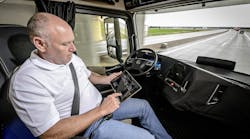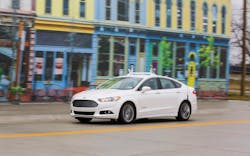There’s no doubt that the debate over autonomous vehicles (AVs) is only going to get fierier in the weeks and months ahead. Just discussing the potential job losses associated with the deployment of driverless trucks, for example, is one surefire way to increase trucker blood pressure.
Yet the reason behind the push to bring more self-driving vehicles – cars and commercial trucks alike – to our roadways is really fairly basic: by removing the fallible and unpredictable “human element” from vehicle operation will lead to far fewer crashes, property damage, injuries, and deaths.
That’s the theory, anyways; one that’s been touched in stories like this one, that one, and oh yeah, this other one over here.
Consulting firm Infiniti Research is the latest “think tank” (for lack of a better term) to take a stab at illustrating the proposed benefits from wider adoption of AVs.
“Their imminent debut in the mainstream scheme of things will reinvent the concept of driving and personal transportation of people and goods,” the firm noted in a recent report.
Here are the three key advantages Infiniti believes AVs will bring to the transportation table:
- Real-time route optimization: AVs on a common stretch of the road are connected together with vehicle-to-vehicle (V2V) and vehicle-to-infrastructure (V2I) mechanisms that enable driverless vehicles to gain real-time information on the condition of the roads as well as exchange protection and mobility information with the surrounding infrastructure and redirect the routes accordingly. Additionally, employing of V2V and V2I to find out optimal routes can aid in reducing the number of miles driven, save time and rein in the fuel consumption.
- Increased lane capacity: AVs can operate at top speeds while trimming down the space between vehicles, leading to greater lane capacity. The latter can also increase with the embracing of adaptive cruise control. This technology adjusts the vehicle’s speed mechanically to ensure a safe distance between the vehicles on that stretch of the road. Such technologies will “shoot up” the lane capacity, Infiniti said, yet reduce accidents – all while ensuring greater passenger comfort and safety, thereby building the customers’ confidence in driverless technology.
- Reduced energy consumption: AVs are less prone to accidents and are actually lighter than the conventional automobiles. Thanks to the lightweight composites used for building the modern vehicle, and the efficient manufacturing procedures, vehicles could become lighter while maintaining their overall size, yet remain impervious to accidents. Lightweight automobiles save on fuel consumption, further aided by such eco-friendly driving technologies and practices as cruise control, deceleration and smooth acceleration.
Yet the biggest benefit AVs offer is improved roadway safety, noted Peter Hart, senior counsel with the LeClairRyan law firm.
He argued in a blog post last month that since driver error is the leading cause of accidents on U.S. roadways – something I’ve noted in this space before – by deploying AVs and taking humans out from behind the steering wheel, many are betting that businesses such as trucking firms, delivery services and shuttle operators will face dramatically fewer legal settlements and court battles triggered by vehicular accidents.
Hart added that AVs promise to make reconstructing accidents vastly easier and more accurate, as they are packed with advanced sensors such as beacon-based locational systems, stereo "vision," Lidar [which stands for “light detection and ranging” radar], GPS and inertia-measurement devices.
“This stands to eliminate some of the most contentious issues in today's accident suits – and possibly put accident-reconstruction experts and proverbial ambulance-chaser lawyers out of work,” he argued. “The absence of a driver or drivers takes issues such as perception-reaction time and driver fatigue out of the mix. Those issues will be litigated with much less frequency."
But that doesn’t mean vehicle-related lawsuits will disappear once AVs hit the road – oh no. For one of the biggest legal questions ahead for AVs is who or what is held liable if there is a crash?
“Most of the accidents thus far have been the result of humans crashing into driverless cars or otherwise causing accidents with them, not the other way around,” Hart noted. “This is not to suggest, however, that all liability risk will vanish.”
Today, he explained that many lawsuits – including the big class action efforts – target manufacturers of conventional cars and trucks for mechanical failures such as faulty steering wheels, braking systems or accelerators.“It is possible that AVs, once introduced onto American roads in sufficient numbers, could cause accidents as manufacturers strive to discover and eliminate the remaining bugs in these systems,” Hart stressed.
"It is easy to imagine the kinds of lawsuits that could occur: 'The manufacturer claimed the car would be safe in the snow,' the plaintiff tells the jury, 'but the car was totally confused in that blizzard and caused a horrific crash,'” he warned. “Most [such] cases would be litigated over which system failed and who is responsible for the failure."
Thus, where AVs are concerned, insurance and liability burdens could tilt away from companies that once employed human drivers and toward manufacturers of driverless vehicles – including those that make autonomous trucks.
I’m going to bet once that particular legal angle starts getting bandied about more frequently, the push to bring AVs to our roadways will slow down a little. We’ll see if that is indeed the case.





